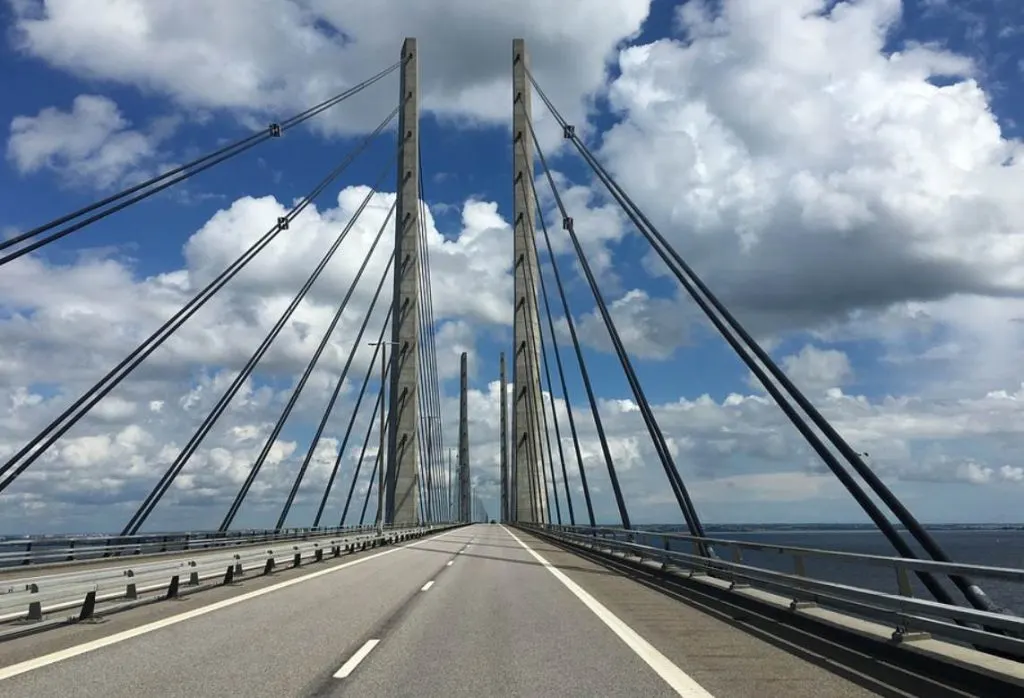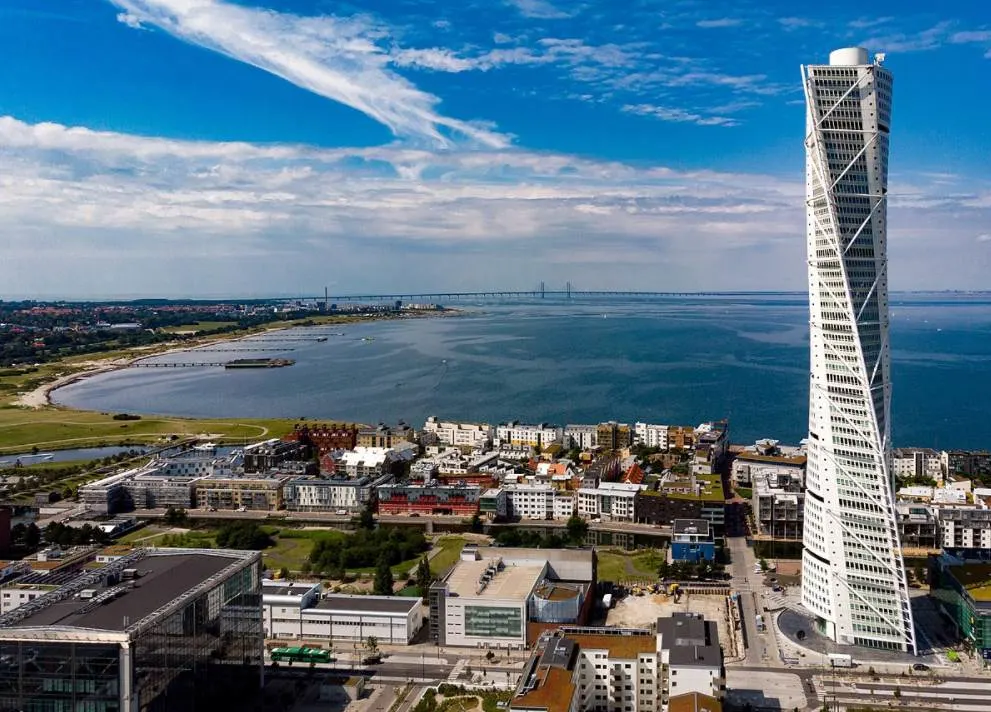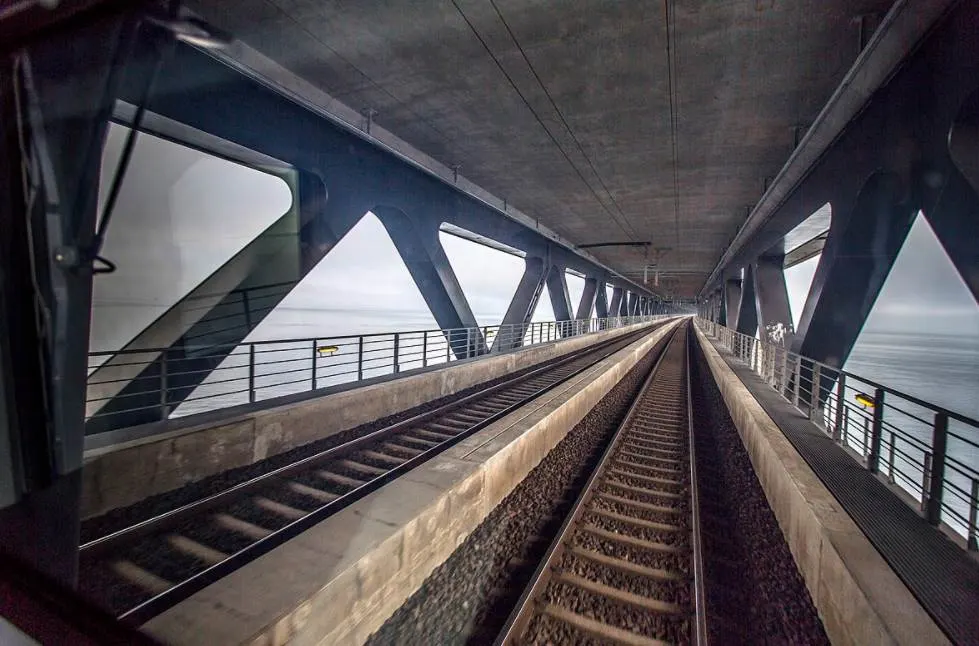One of the greatest bridges in the world connects two Scandinavian countries in Northern Europe. It also connects two of the largest cities in both countries, making it a very important structure.
In this article, you’ll discover some of the most interesting facts about the Øresund Bridge so you can learn everything there is to know about this engineering marvel.
1. It spans a strait with the same name between Denmark and Sweden
The Øresund Bridge is an enormous structure that spans the Øresund Strait, a strait on the border of Denmark and Sweden. This strait is commonly referred to as “The Sound” in English and has a width of anywhere between 4 and 28 kilometers (2.5 and 17 miles).
The bridge was constructed in the best possible location. That’s because it directly connects Copenhagen, the capital and largest city of Denmark, and Malmö, the third-largest city in Sweden.
The bridge is a combination of a road and railway bridge and carries the international European route E20 across the strait. The railway road is called the Øresund Line and provides a connection between Copenhagen and Malmö in just 40 minutes.

2. Part of the crossing near Denmark consists of a tunnel
One of the most interesting facts about the Øresund Bridge is that not the entire crossing consists of a bridge. The section near Denmark is completed via the so-called Drogden Tunnel.
An artificial island was constructed in the middle of the strait called Peberholm. This island covers an area of 1.3 square kilometers (0.50 square miles) and was built specially to switch from the bridge to the tunnel.
The Drogden Tunnel has a length of 4.05 kilometers (2.52 miles) and was constructed because extending the bridge could have interfered with air traffic from the nearby Copenhagen Airport on the Danish island of Amager.

3. Several reasons delayed the construction until the 1990s
Building a bridge or tunnel across the Øresund strait was an item on the agenda of both the Danish and Swedish local governments for the entire 20th century. The first proposal to build a tunnel for railway traffic was made way back in 1910.

A consortium of engineering firms was established and it proposed to build a bridge across the strait in 1936, but these plans were shelved when World War II broke out. Many proposals were made during the decades after the war but none of them led to a plan that was accepted.
An agreement to build a fixed link was finally signed in 1973 and all options were being thoroughly investigated at the time, including at the narrowest point of the strait between Helsingør–Helsingborg.
The final delay was caused because of the Danish Government which gave priority to the construction of the Great Belt Fixed Link, a similar project that connects the Danish islands of Zealand and Funen across the Great Belt Strait.
The Great Belt crossing was completed between 1991 and 1998 and the Øresund Bridge between 1995 and 1999. It officially opened for traffic on July 1, 2000.

4. The bridge has astounding dimensions
The fact that this bridge and tunnel were completed in just 4 years can be described as an engineering miracle. This becomes especially clear when you take a closer look at some of the remarkable stats of the structure:
- Length: 7,845 meters (25,738 feet)
- Longest span: 490 meters (1,608 feet)
- Width: 23.5 meters (77.1 feet)
- Maximum height: 204 meters (669 feet)
- Deck height: 57 meters (187 feet)
The bridge is a combination of a girder and cable-stayed bridge. The reason this type of design was chosen was to allow trains to pass the bridge that carries a heavy load on the superstructure.

5. Crossing the bridge is an amazing experience but rather expensive
The bridge was an extremely expensive project to complete as it cost a total of 2.6 billion EUR. This is the equivalent of 19.6 billion DKK and 25.8 billion SEK.
This makes it all the more remarkable that none of this money was directly paid by the taxpayers of both Denmark and Sweden, except for the plots of land that were used to build the approaches of the structure.
The entire project will be paid from the toll collected from vehicles that want to cross it. This is expected to take approximately 30 years as regular vehicles are required to pay 55 EUR for a single ticket, quite expensive indeed!

More interesting facts about the Øresund Bridge
6. The E20 road that crosses the Øresund Strait via the bridge has a length of 1,880 kilometers (1,170 miles) but isn’t a continuous road. It starts in Ireland in the west, continues via Dublin to Liverpool, and runs all across northern Europe from Stockholm to Tallinn in Estonia.
7. If you plan to cross the bridge from Denmark to Sweden then you’ll be able to admire one of the most amazing skyscrapers in the world to your left.
A revolutionary structure was completed in Malmö in the early 21st century called the “Turning Torso,” a reference to the twisting design of the tower. This building was a pioneering structure as its design has been replicated in cities all around the world.

8. The vicinity of the Copenhagen Airport wasn’t the only reason why the bridge wasn’t extended to Denmark but completed with the Drogden Tunnel.
The other two important reasons were to provide a clear passage for ships, regardless of the weather conditions, and to avoid huge chunks of ice to block the passage altogether. Yes, it can be very cold in this part of Europe!
9. The railway line crosses from Denmark to Sweden but this caused a major problem. Trains in Denmark drive on the right while in Sweden they drive on the left. Before 2010, the change was made at Malmö Central Station.
This changed when the Malmö City Tunnel was constructed between 2005 and 2010 as this transition is now made within this tunnel.

10. The Drogden Tunnel has a length of 4,050 meters (2.52 miles) and only consists of 20 prefabricated parts of reinforced concrete. These are the largest of their kind in the world and eight 55,000 tonnes (yes, that’s 55 million kilos) each.
11. The marine creatures living in the Öresund strait have been very happy with the bridge. That’s because the underwater sections of the bridge have become an artificial reef in which they can dwell.
12. Peberholm, the artificial island that was created as part of the bridge and tunnel project, was constructed using soil dug up during construction. It has a length of approximately 4 kilometers (2.5 miles), a height of 20 meters (66 feet), and a maximum width of 500 meters (1,640 feet).
The name of the island translates to “Pepper Islet,” a name chosen by the Danish people to complement the natural island of “Saltholm” which translates to “Salt Islet.”

